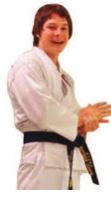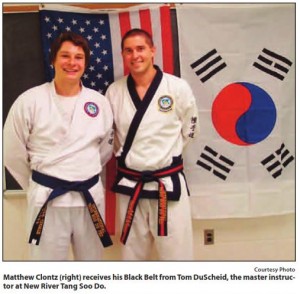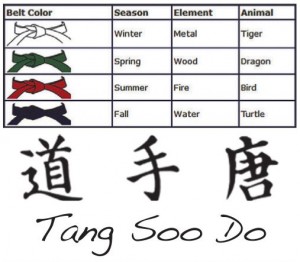By CALVIN PYNN calvin@southwesttimes.com  Before his freshman year at Virginia Tech Matthew Clontz had never practiced martial arts. “I figured I needed something to keep me in shape, and I wanted to learn a way to defend myself, as well,” Clontz said, referring to his search for an intramural sport to participate in when he started college. He graduated from Pulaski County High School in 2010. Fortunately for him, he came across the Tang Soo Do Karate Organization at Virginia Tech. Four years later, Clontz, now 22 years old and a second year graduate student at Virginia Tech, is an instructor in Tang Soo Do, And recently earned his black belt. According to Clontz, Tang Soo Do has helped him develop ideals and virtues that he has held throughout his time in college. “Honestly, it’s taught me a lot of patience,” Clontz said. “Obviously being an 18-year-old guy when I first started, I was a little bit of a hot head at first. It was a bit of a transition at first, but I think in the long run it’s really helped me out with a lot of other experiences.” Having somebody in charge of him to obey while practicing was the best aspect of the martial art as he was learning the ropes, he said. His four years of training led him to the International Tang Soo Do Federation Headquarters in Pittsburgh, Pa. in April, where he tested for his black belt along with nearly 100 other students. Testing at the Headquarters is a mandatory requirement for Tang Soo Do students who have managed to train for a certain number of hours, Clontz said. He said there was a broad age range for the students participating. Some were even as young as 11 or 12 years old. “It probably seemed less intense for them,” Clontz said of the younger students. “For me going up there, being 22 years old, I was determined to show how good I was, and it was definitely intense.” While there, Clontz and the other students tested in front of Grandmaster CS Kim, the federation’s founder. Kim, now in his 70’s, has been on more black belt magazine covers than any other martial artist other than Bruce Lee, according to Clontz. With Kim’s tutelage, Clontz also had the opportunity to go down a similar path as another famous martial arts legend, as Kim trained actor Chuck Norris to his first black belt. Quoting Kim, Clontz relayed the philosophy behind Tang Soo Do as more than just a typical physical fighting style.
Before his freshman year at Virginia Tech Matthew Clontz had never practiced martial arts. “I figured I needed something to keep me in shape, and I wanted to learn a way to defend myself, as well,” Clontz said, referring to his search for an intramural sport to participate in when he started college. He graduated from Pulaski County High School in 2010. Fortunately for him, he came across the Tang Soo Do Karate Organization at Virginia Tech. Four years later, Clontz, now 22 years old and a second year graduate student at Virginia Tech, is an instructor in Tang Soo Do, And recently earned his black belt. According to Clontz, Tang Soo Do has helped him develop ideals and virtues that he has held throughout his time in college. “Honestly, it’s taught me a lot of patience,” Clontz said. “Obviously being an 18-year-old guy when I first started, I was a little bit of a hot head at first. It was a bit of a transition at first, but I think in the long run it’s really helped me out with a lot of other experiences.” Having somebody in charge of him to obey while practicing was the best aspect of the martial art as he was learning the ropes, he said. His four years of training led him to the International Tang Soo Do Federation Headquarters in Pittsburgh, Pa. in April, where he tested for his black belt along with nearly 100 other students. Testing at the Headquarters is a mandatory requirement for Tang Soo Do students who have managed to train for a certain number of hours, Clontz said. He said there was a broad age range for the students participating. Some were even as young as 11 or 12 years old. “It probably seemed less intense for them,” Clontz said of the younger students. “For me going up there, being 22 years old, I was determined to show how good I was, and it was definitely intense.” While there, Clontz and the other students tested in front of Grandmaster CS Kim, the federation’s founder. Kim, now in his 70’s, has been on more black belt magazine covers than any other martial artist other than Bruce Lee, according to Clontz. With Kim’s tutelage, Clontz also had the opportunity to go down a similar path as another famous martial arts legend, as Kim trained actor Chuck Norris to his first black belt. Quoting Kim, Clontz relayed the philosophy behind Tang Soo Do as more than just a typical physical fighting style.  “We don’t do Tang Soo Do to become better martial artists, we do it to become better people,” Clontz said. “It teaches us self defense, but it also teaches us respect and discipline.” “Every event I’ve ever been to with him, he really tries to reinforce that,” he said of Kim. “It’s [not] all about just punches, kicks, blocks and beating people up.” According to Clontz, the three hour test was broken into sections. For the first part, the students demonstrated their self-defense moves, such as wrist blocking. The second part involved sparring between two people. For this section, two people entered, designated as an attacker and defender, in which the attacker came at the defender, who blocked those moves and tried to counter attack. Another part of the test took a break from the physical aspect of Tang Soo Do and focused on terminology, Clontz said. After that, the next section consisted of breaking boards, for which each student chose their own unique combination of moves. Clontz decided to depart from the traditional competition-based style of board breaking and Instead went for something a little more authentic. “I’m not a big fan of that method because they’re more competition based, and not as much like a real world situation,” Clontz said. His test included a jump side kick, back kick, and ridge hand in a quick succession to simulate an actual scenario where he would be attacked by multiple people. The final portion of the test consisted of various hand feet combinations, involving a series of blocks and punches.
“We don’t do Tang Soo Do to become better martial artists, we do it to become better people,” Clontz said. “It teaches us self defense, but it also teaches us respect and discipline.” “Every event I’ve ever been to with him, he really tries to reinforce that,” he said of Kim. “It’s [not] all about just punches, kicks, blocks and beating people up.” According to Clontz, the three hour test was broken into sections. For the first part, the students demonstrated their self-defense moves, such as wrist blocking. The second part involved sparring between two people. For this section, two people entered, designated as an attacker and defender, in which the attacker came at the defender, who blocked those moves and tried to counter attack. Another part of the test took a break from the physical aspect of Tang Soo Do and focused on terminology, Clontz said. After that, the next section consisted of breaking boards, for which each student chose their own unique combination of moves. Clontz decided to depart from the traditional competition-based style of board breaking and Instead went for something a little more authentic. “I’m not a big fan of that method because they’re more competition based, and not as much like a real world situation,” Clontz said. His test included a jump side kick, back kick, and ridge hand in a quick succession to simulate an actual scenario where he would be attacked by multiple people. The final portion of the test consisted of various hand feet combinations, involving a series of blocks and punches.  After passing the tests at the Federation Headquarters in Pittsburgh, Clontz was presented with his black belt nearly three months later, on July 19. This is an achievement that less than 10 percent of all martial arts students manage to achieve. Now that he has his black belt, Clontz plans to move forward to continue developing his skills as a martial artist. “I’m just gonna keep working, and keep getting better,” he said. “I’m gonna try to get better myself, but also try to get better at teaching and help the others to enjoy it so much get better as well.” While only 10 percent of martial arts students train long enough to earn their black belt, less than 1 percent go long enough to earn the rank of master. That is Clontz’s long-term goal as a martial artist. With four years of training under his black belt, Clontz has another nine to go before he can think about becoming a Tang Soo Do master. In the mean time, however, he has managed to embody the principals of the martial art, and knows how to impart those principals on his future students. “Be aware of your situation and your surroundings,” he said. “If you’re aware and you realize you’re starting to get into a bad situation, if you know what’s happening, it’ll be easier to diffuse it. At the same time, if you’re aware, even if it does come to violence, you’re prepared, and you can finish it as soon as it starts.” Clontz is in his second year of grad school studying mechanical engineering at Virginia Tech, and working as a graduate teaching assistant. Outside of that, he is now the president and instructor of the Tang Soo Do Organization at Virginia Tech, taking over for his own instructor Tom DuScheid, who runs New River Tang Soo Do in Blacksburg. Thank you to The Southwest Times for this excellent article. Please visit southwesttimes.com for more great articles and news on Southwestern Virginia.
After passing the tests at the Federation Headquarters in Pittsburgh, Clontz was presented with his black belt nearly three months later, on July 19. This is an achievement that less than 10 percent of all martial arts students manage to achieve. Now that he has his black belt, Clontz plans to move forward to continue developing his skills as a martial artist. “I’m just gonna keep working, and keep getting better,” he said. “I’m gonna try to get better myself, but also try to get better at teaching and help the others to enjoy it so much get better as well.” While only 10 percent of martial arts students train long enough to earn their black belt, less than 1 percent go long enough to earn the rank of master. That is Clontz’s long-term goal as a martial artist. With four years of training under his black belt, Clontz has another nine to go before he can think about becoming a Tang Soo Do master. In the mean time, however, he has managed to embody the principals of the martial art, and knows how to impart those principals on his future students. “Be aware of your situation and your surroundings,” he said. “If you’re aware and you realize you’re starting to get into a bad situation, if you know what’s happening, it’ll be easier to diffuse it. At the same time, if you’re aware, even if it does come to violence, you’re prepared, and you can finish it as soon as it starts.” Clontz is in his second year of grad school studying mechanical engineering at Virginia Tech, and working as a graduate teaching assistant. Outside of that, he is now the president and instructor of the Tang Soo Do Organization at Virginia Tech, taking over for his own instructor Tom DuScheid, who runs New River Tang Soo Do in Blacksburg. Thank you to The Southwest Times for this excellent article. Please visit southwesttimes.com for more great articles and news on Southwestern Virginia.



